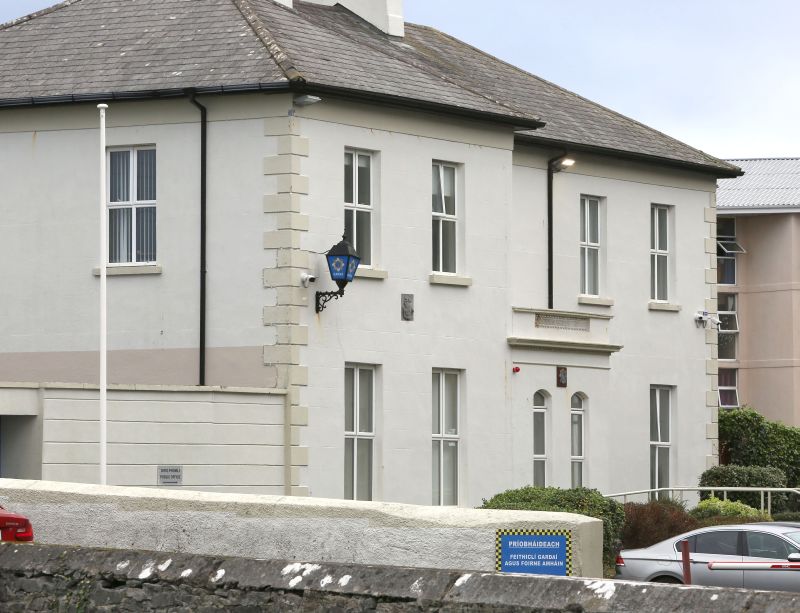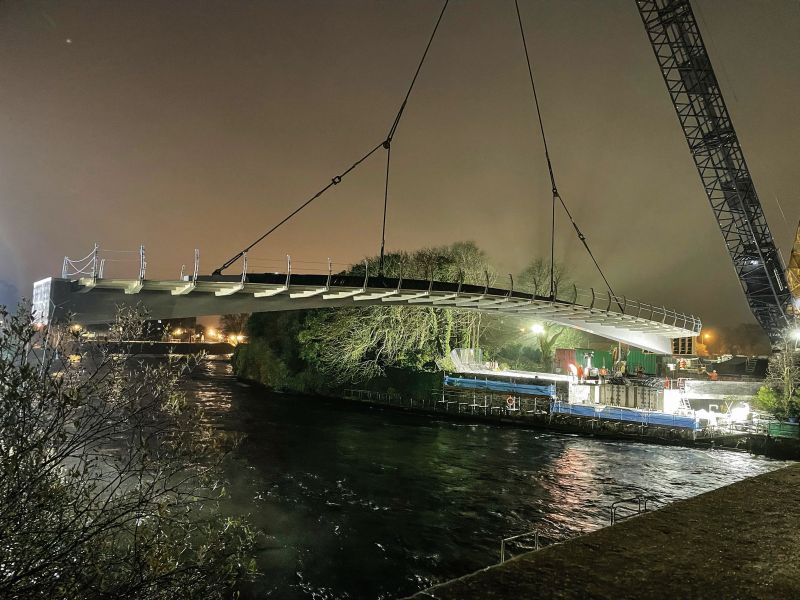CITY TRIBUNE
Former mayor claims Salthill Garda Station’s 24-hour status is ‘under threat’

From the Galway City Tribune – A former mayor of Galway has claimed the 24-hour status of Salthill Garda Station remains under threat.
Councillor Donal Lyons (Ind) previously highlighted in this newspaper that ten gardaí had been transferred out of Salthill in September to other stations within the Division.
At the time, senior Gardaí said that Salthill would remain a 24-hour station. But Cllr Lyons said he remains concerned that it will be downgraded, with shorter opening times in the near future.
“I’m not being alarmist about this, but to take ten guards out of a garda station is a lot. The explanation was that Salthill no longer has to cover Connemara, but the detective unit was ears on the ground. Five have gone – four detectives and a detective sergeant were reassigned to Mill Street.
“It would appear to me that they are beginning to wind down Salthill, reduce its garda personnel and at some stage in the future they will say, ‘Now we are only able to open Salthill certain hours of the day as distinct to a 24-hour station’,” said Cllr Lyons.
He said that there are 20,000 residents in Knocknacarra alone and it needs more gardaí.
“It’s bigger than most towns, and all we have is three community gardaí and a sergeant. Their presence is often needed for prison or court duties,” he said.
Cllr Lyons said Salthill could suffer a similar fate to other West of Ireland stations that were downgraded.
“Kiltimagh and Swinford have no garda presence in their stations after certain hours. I can foresee the same thing happening here, because of the reduction in staff. In order to have a police presence, 24 hours, they have to have personnel in the station.
“At least a quarter of gardaí have been taken out of Salthill, if not more. Losing ten personnel is worrying and it doesn’t augur well for the future of Salthill as a 24-hour station. I’m not being alarmist when I say that.
“I’m not taking away from the excellent work the gardaí do, but from an operational point of view those that are making these decisions in Garda HQ will say Mill Street is less than five kilometres from Salthill,” said Cllr Lyons.
Another problem faced by gardaí policing Salthill and Knocknacarra was a shortage of patrol cars, he claimed.
“There is a shortage of garda cars, not alone in Galway but right across the country. Overall, it’s my understanding that when constituents ring to say there is a problem in an area, they are being informed that there is no garda car available,” Cllr Lyons added.
At last month’s Galway City Joint Policing Committee meeting, Superintendent Damien Flanagan urged people to allow time for the new organisational structure of the Galway Garda Division to bed in.
The re-organisation came into force in September with County Galway split into three ‘Community Engagement Areas’; one in Galway City, one in Galway County East and one in Galway County West.
The Superintendent for County West is based in Oranmore Garda Station, and is responsible for all of Connemara, which up to now was led from Salthill.
CITY TRIBUNE
Galway ‘masterplan’ needed to tackle housing and transport crises

From the Galway City Tribune – An impassioned plea for a ‘masterplan’ that would guide Galway City into the future has been made in the Dáil. Galway West TD Catherine Connolly stated this week that there needed to be an all-inclusive approach with “vision and leadership” in order to build a sustainable city.
Deputy Connolly spoke at length at the crisis surrounding traffic and housing in Galway city and said that not all of the blame could be laid at the door of the local authority.
She said that her preference would be the provision of light rail as the main form of public transport, but that this would have to be driven by the government.
“I sat on the local council for 17 years and despaired at all of the solutions going down one road, metaphorically and literally. In 2005 we put Park & Ride into the development plan, but that has not been rolled out. A 2016 transport strategy was outdated at the time and still has not been updated.
“Due to the housing crisis in the city, a task force was set up in 2019. Not a single report or analysis has been published on the cause of the crisis,” added Deputy Connolly.
She then referred to a report from the Land Development Agency (LDA) that identified lands suitable for the provision of housing. But she said that two-thirds of these had significant problems and a large portion was in Merlin Park University Hospital which, she said, would never have housing built on it.
In response, Minister Simon Harris spoke of the continuing job investment in the city and also in higher education, which is his portfolio.
But turning his attention to traffic congestion, he accepted that there were “real issues” when it came to transport, mobility and accessibility around Galway.
“We share the view that we need a Park & Ride facility and I understand there are also Bus Connects plans.
“I also suggest that the City Council reflect on her comments. I am proud to be in a Government that is providing unparalleled levels of investment to local authorities and unparalleled opportunities for local authorities to draw down,” he said.
Then Minister Harris referred to the controversial Galway City Outer Ring Road which he said was “struck down by An Bord Pleanála”, despite a lot of energy having been put into that project.
However, Deputy Connolly picked up on this and pointed out that An Bord Pleanála did not say ‘No’ to the ring road.
“The High Court said ‘No’ to the ring road because An Bord Pleanála acknowledged it failed utterly to consider climate change and our climate change obligations.
“That tells us something about An Bord Pleanála and the management that submitted such a plan.”
In the end, Minister Harris agreed that there needed to be a masterplan for Galway City.
“I suggest it is for the local authority to come up with a vision and then work with the Government to try to fund and implement that.”
CITY TRIBUNE
Official opening of Galway’s new pedestrian and cycle bridge

The new Salmon Weir pedestrian and cycle bridge will be officially opened to the public next Friday, May 26.
Work on the €10 million bridge got underway in April 2022, before the main structure was hoisted into place in early December.
A lunchtime tape-cutting ceremony will take place on Friday, as the first pedestrians and cyclists traverse the as-yet-unnamed bridge.
The Chief Executive of Galway City Council, Brendan McGrath, previously said the bridge, once opened, would remove existing conflicts between pedestrians, cyclists and traffic “as well as facilitating the Cross-City Link public transport corridor over the existing 200-year-old bridge”.
The naming of the new bridge has been under discussion by the Council’s Civic Commemorations Committee since late last year.
One name that has been in the mix for some time is that of the first woman in Europe to graduate with an engineering degree – Alice Perry.
Ms Perry, who was from Wellpark, graduated from Queen’s College Galway (now University of Galway) in 1906. The university’s engineering building is named in her honour.
The bridge was built by Jons Civil Engineering firm in County Meath and was assembled off-site before being transported to Galway. Funding for the project was provided in full by the National Transport Authority and the European Regional Development Fund.
(Photo: Sheila Gallagher captured the city’s new pedestrian footbridge being raised on the south side of the Salmon Weir Bridge in December. It will officially open next Friday, May 26).
CITY TRIBUNE
Minister branded ‘a disgrace’ for reversing land rezoning in Galway City

From the Galway City Tribune – Minister of State for Local Government and Planning, Kieran O’Donnell was labelled a “disgrace” for overturning councillors’ decisions to rezone land in the new City Development Plan.
Minister O’Donnell (pictured) confirmed in a letter to Council Chief Executive Brendan McGrath last week that he was reversing 25 material alternations made by councillors to the CDP 2023-29. He made the decision on the advice of Office of Planning Regulator (OPR).
Minister O’Donnell directed that 14 land parcels that were subject to land-use zoning changes by councillors as part of the Material Alterations to the Draft CDP should be reversed.
He directed that a further 11 land parcels in the city should become “unzoned”.
The Minister found that the CDP had not been made in a manner consistent with recommendations of the OPR, which required specific changes to the plan to ensure consistency with the national planning laws and guidelines.
At last week’s Council meeting Cllr Eddie Hoare (FG) asked for clarity on the process by which councillors could rezone the lands that had been changed by the Minister’s direction.
Cllr Declan McDonnell said, “What he [Minister O’Donnell] has done is an absolute disgrace”.
And he asked: “Do we have to have another development plan meeting to deal with it?”
Both Cllrs Hoare and McDonnell wondered what would become of the lands that were rezoned or unzoned by the ministerial direction.
Mr McGrath said the Council had put forward an argument in favour of retaining the material alterations in the plan, but ultimately the Minister sided with OPR.
He said if councillors want to make alterations to the new plan, they could go through the process of making a material alteration but this was lengthy.
The Save Roscam Peninsula campaign welcomed the Minister’s decision.
In a statement to the Galway City Tribune, it said the direction would mean the Roscam village area on the Roscam Peninsula will be unzoned and a number of land parcels would revert back to agriculture/high amenity.
A spokesperson for the campaign said: “the material alterations made by city councillors following lobbying by developers continued the long-standing practice of councillors facilitating a developer-led plan rather than an evidence- and policy-based plan that meets the needs of the city.
“The Minister’s direction is an important step in restoring confidence in the planning system. It is clear from the City Council’s own evidence on future housing projections that there was no requirement to zone these lands for residential purposes in order to meet the needs of the targeted population increase up to 2029,” the spokesperson added.









